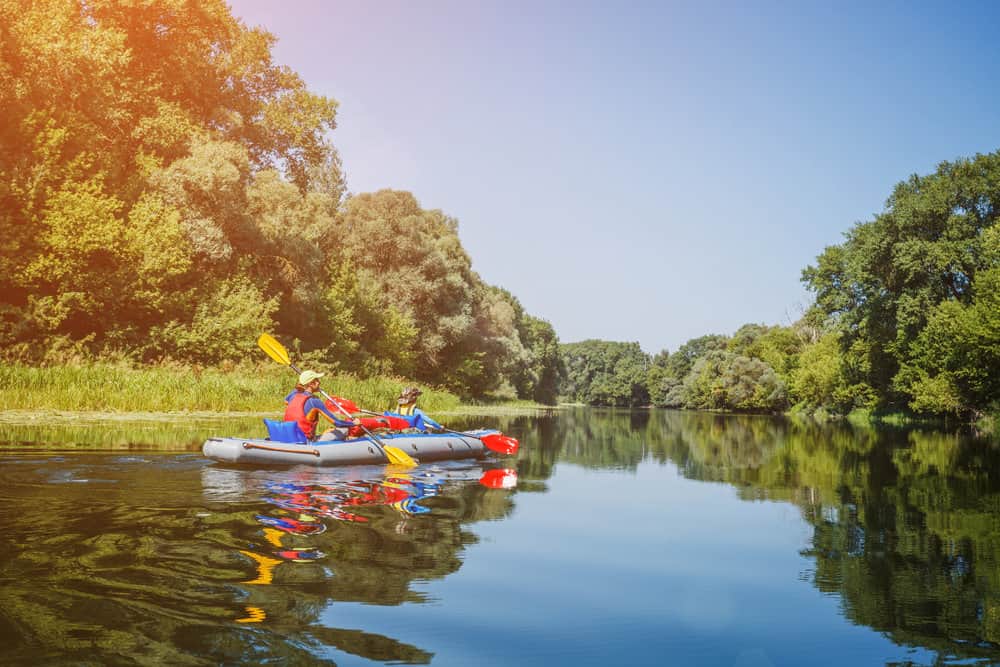So you’ve decided to get an inflatable kayak
Great!
Now the next question is, how do you choose a good paddle?
Yes, most kayaks come with a free paddle.
But as you use these, you’ll realize it’s not great.
They’re heavy, uncomfortable, and can easily get damaged after a few trips.
That’s why you should look for the best paddle for inflatable kayaks.
Choosing one is much more than just getting the right length.
You also have to consider the shaft, the blade, the feather, and more.
But don’t worry.
Today, we’re looking at the complete guide to choose an inflatable kayak paddle.
We’re going in-depth into every aspect, so you’ll come away with the perfect one.
Ready?
Let’s go.
Table of Contents
How to Choose Inflatable Kayak Paddle Length
Let’s start with the basics.
How long should your paddle be?
Generally, 85-95 inch paddles are best for inflatable kayaks.
At this length range, you shouldn’t run into any big problems.
But hey…
We want specific numbers here.
What is the perfect length for you?
Well, that depends on three things:
- Your kayak’s width
- Your height
- Your paddling style
Let’s take a closer look at each one.
1. Your Kayak’s Width
Inflatable kayaks are wide, much wider than hard-shells.
This is the reason you need longer paddles with inflatables.
However, some inflatable kayaks are wider than others.
As a rule of thumb, 85-90 inch paddles work best with kayaks less than 33 inches wide. Above that, you should get a 95-inch paddle.
That said, there is another factor that is very important to consider.
Height.
2. Your Height
The taller you are, the higher your hands are going to be from the water.
This is why tall people have to work twice as hard with short paddles.
While short people won’t feel comfortable with long paddles.
It’s something you need to consider when choosing an inflatable kayak.
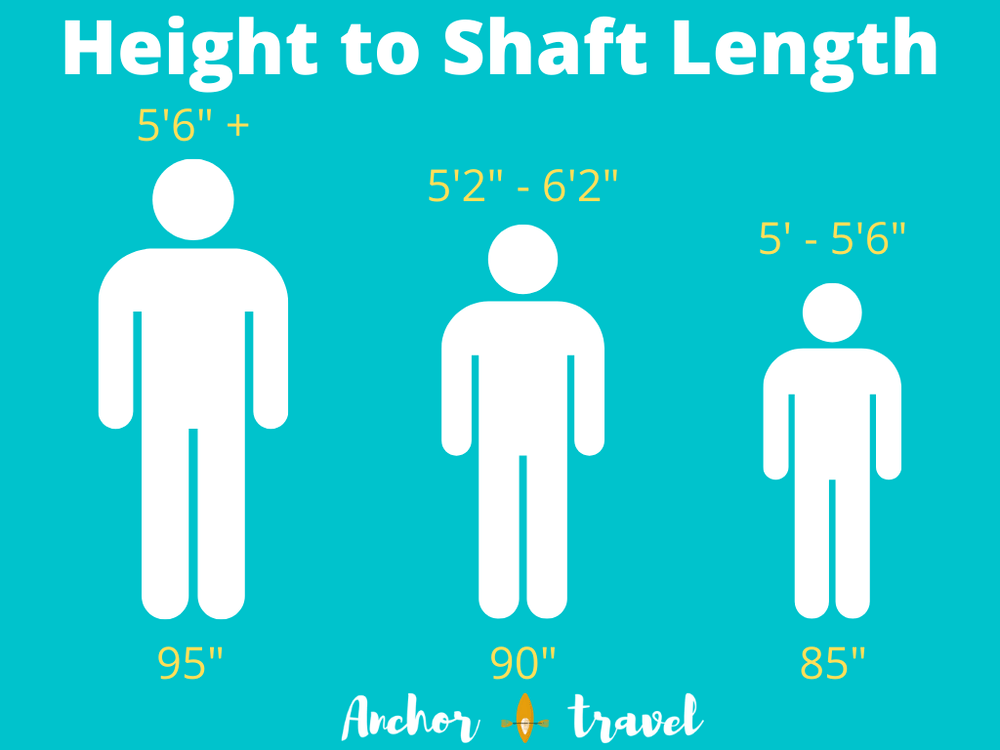
How does this stack up with your kayak’s width?
Good question.
Check out this helpful chart:
| Height: | 23” – 28” wide | 29” – 32” wide | > 32” |
| < 5’ | 85” | 90” | 95” |
| 5’ – 5’6” | 85” | 90” | 95” |
| 5’6” – 6’ | 85” | 90” | 100” |
| > 6’ | 90” | 95” | 100” |
This should give you a good idea of the ideal length of your paddle.
But there’s one more thing to consider…
3. Paddling Style
Whether you realize it or not, you are paddling in one of two styles.
Do you enjoy paddling aggressively and making sharp turns?
If so, you might want a shorter paddle.
Short paddles are better suited for high-angle, aggressive rowing.
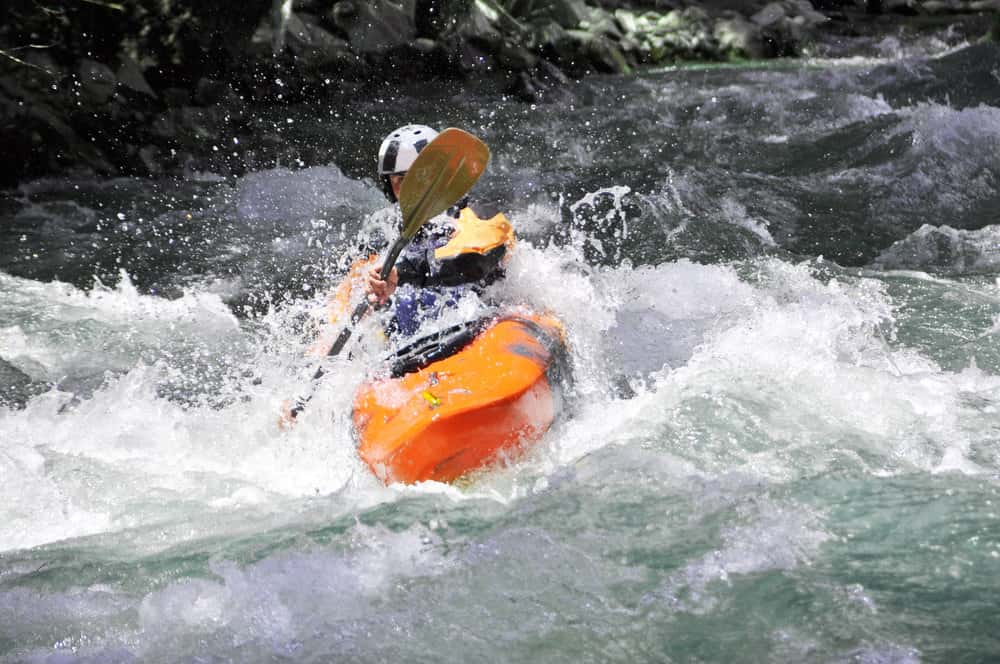
High-angle paddling is perfect for going fast and making sharp turns
Or are you someone who prefers long and chill kayaking trips?
Low-angle paddling (paddling almost horizontally to the water) is better suited for people who like this.
And a longer paddle is better suited for low-angle paddling.
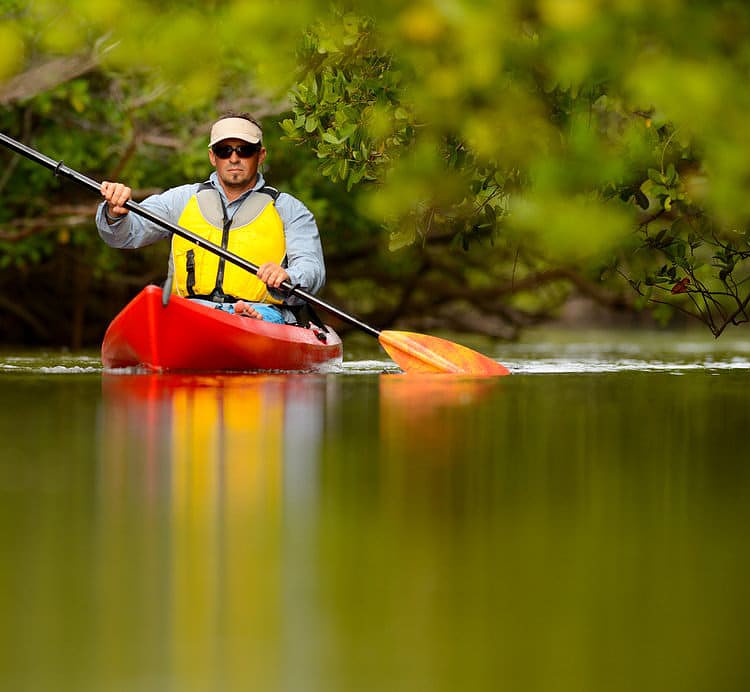
Low-angle paddling is best for relaxed rowing
Now, you could paddle high-angle with a long paddle (and vice versa).
But if you’re looking for the perfect paddle length, you should consider the style you use.
How to Choose Kayak Paddle Shaft
Choosing a great paddle is so much more than just getting the right length.
Pick one with a bad shaft, you’ll feel uncomfortable and unhappy no matter how perfect the size.
But what separates a good shaft from a trash one?
There are five things you should consider:
- Material
- Breakdown
- Feather
- Diameter
- Shape
Material
Kayak paddles come in three materials:
- Aluminum
- Fiberglass
- Carbon Fiber
Aluminum is the cheapest option available.
Most free paddles are made from this. It’s strong and gets the job done.
However, there is a lot to be desired with aluminum shaft paddles.
For one, they are quite heavy.
On paper, 1-2 extra lbs might not seem like a lot.
But trust me, when you’re paddling for hours, your arms will feel this.
Aluminum is also the least corrosion-resistant material.
You’ll have to rinse and dry these after every trip. Otherwise, you’ll get rusted paddles.
But hey, they’re hella cheap.
Fiberglass is the middle-ground material.
Compared to aluminum, fiberglass shafts are stronger, lighter, and more corrosion-resistant.
However, they’re also more expensive.
And they’re not quite at the level of carbon fiber either.
Fiberglass shafts are the perfect middle-ground.
Nonetheless, fiberglass is the perfect material for those looking for an upgrade from their free paddles.
It’s far better than aluminum, and not as expensive as carbon fiber.
Carbon fiber is the ultimate material for paddle shafts.
This is by far the best material for kayak paddles.
It’s super lightweight, extra tough, and extremely corrosion-resistant.
No surprise that professionals use only carbon fiber paddles.
Unfortunately, as you can probably guess, carbon fiber paddles are expensive.
Very expensive.
But if you’re looking for the best of the best, it’s well worth the extra dollars.
Breakdown
Convenience or performance?
That is the question.
When looking for a kayak paddle, consider how many pieces you can break it down into.
You’ll find one-piece, two-piece, and four-piece paddles.
One-piece paddles are the strongest and most lightweight. They’re the best in terms of performance.
But they can be quite a hassle to bring along. Especially for inflatable kayak users.
That’s why I recommend you get either a two-piece or four-piece.
The more you break down a paddle, the heavier and less stable it becomes. However, it also becomes a lot more convenient.
And hey… I’m sure one of the reasons you chose an inflatable kayak instead of a hard-shell was for its convenience.
Just make sure you check how sturdy the paddle is.
High-quality breakdown paddles are still super sturdy despite the fact you can detach them.
A high-quality four-piece paddle like the Solstice is both sturdy and extremely convenient.
Cheapos, on the other hand, will loosen up with every stroke.
Feather
Something you might not have known about is the feather of kayak paddles.
This refers to the angle difference between the two blades.
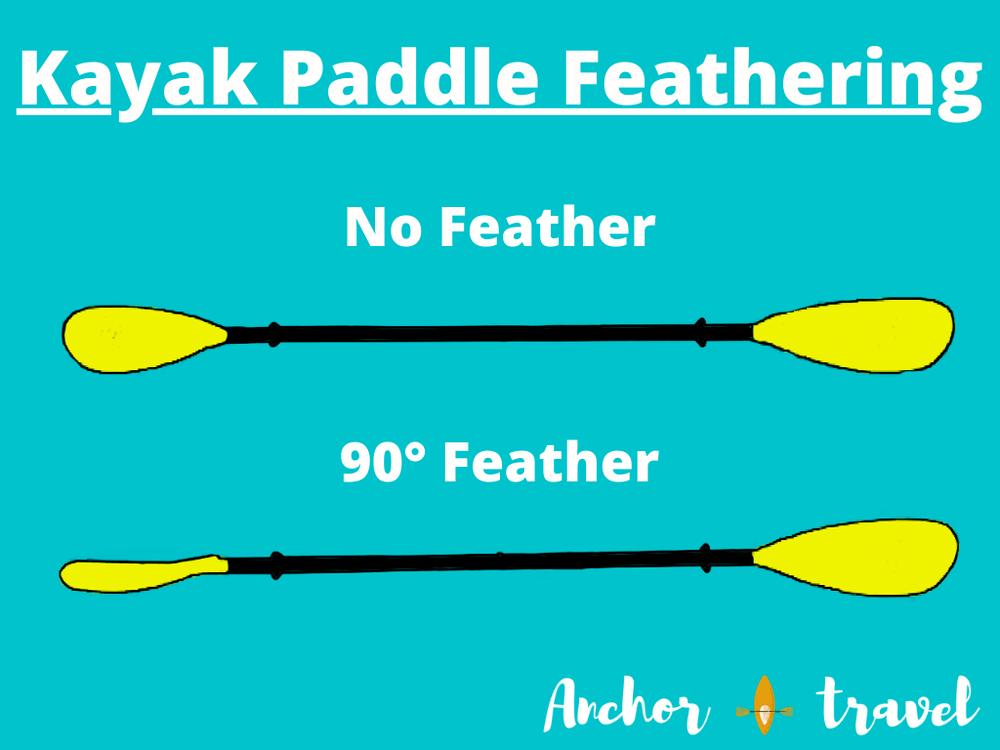
Feathering makes it easier for you to row into the wind.
As one blade is on the water, the other will be perpendicular to the wind. The blade will slice through the air and experience far less wind resistance.
This might seem unnecessary, and many kayakers don’t like how feathering forces them to turn their wrists at every stroke.
But if you paddle into the wind, you’ll find it will make your life a lot easier.
Paddles come with no feathering, 90-degree feathering, 60-degree feathering, as well as adjustable feathering.
Which is the best?
That all depends on you.
Your free paddle will most likely have no feathering. So test it out.
See if paddling into the wind is something you struggle with.
Diameter
What good is a paddle if you can’t hold on to it?
A fat paddle will tire your hands out very quickly.
Get a paddle that you can grasp firmly – where your thumb can wrap around and meet your fingers.
Most kayak paddles come in two sizes: standard and small-diameter.
Unless your hands are small – or if you’re a child – you should be able to grip a standard size paddle.
If not, then go for the small-diameter.
This will make your trips a lot merrier.
Shape
Last but not least, you need to consider the shape of your shaft.
You’ll find straight shafts and bent shafts.
Bent shafts are supposed to be easier on your wrists. However, they are slightly heavier than straight shafts.
And when it comes to paddle weight, an extra pound is a lot.
That said, some people find straight shafts better for their wrists.
It’s all a matter of preference.
How do you know which one you’ll like better?
Well, you can’t unless you test it out.
The best thing to do is to try out the free paddle with your kayak.
This is almost always straight shafted. So try it out and see if your wrists feel strained.
How to Choose Kayak Paddle Blade
Finally, we get to the tip of the paddle, the blade.
As you probably know by now, this is a critical part of every paddle.
It doesn’t matter how perfect everything else is.
Poor blade = poor paddle.
So what should you look for in your blade?
Two things.
1. Shape
Paddle blades come in a plethora of shapes.
You’ll find some short and fat, while others are long and thin.
You’ll find some with symmetrical sides, while others are asymmetrical.
You’ll find some curved, while others are spooned.
What are all these differences about?
For starters, all you need to know is the length and width of the blade.
Long, thin blades are better suited for low-angle rowing.
They’re lighter and allow you to stroke smoothly. You won’t waste any energy with a paddle like this.
Short, fat blades are perfect for high-angle rowing.
They’re broad and can bite the water hard. For fast and sharp kayaking, this is the blade you need.
These are the two things every kayaker should know.
There are more differences, but these don’t make a huge impact.
2. Material
Like the shaft, kayak paddle blades also come in a bunch of different materials.
The three most common being plastic, fiberglass, and carbon fiber.
Plastic (or polypropylene) blades are the cheapest ones around.
You might think that because it’s plastic, it must be weak.
However, it’s quite the opposite.
Because polypropylene is flexible, you can hit rocks with these paddles without worry.
It’s never going to shatter or break.
That said, its flexibility also reduces its bite.
As you row hard, the water will push back on the flexible blade and bend it.
Yes, it will still propel you forward. But not as efficiently as you might like.
Fiberglass blades are, once again, the middle ground.
Unlike the shaft though, blades rarely come in pure fiberglass.
This is because if they do, it’ll shatter the moment you strike a rock.
Instead, fiberglass paddles are polypropylene with a fiberglass backbone.
This gives you the durability of plastic with the stiffness of fiberglass.
You can go much faster thanks to the extra strength of fiberglass blades.
Carbon fiber blades, as you might have guessed by now, are the ultimate paddle blades.
Once again, they are the lightest and most durable type around.
Despite its weight, carbon fiber blades are stiff. You get a great bite of water with every stroke – pushing you forward fast.
That’s why professionals love these. It’s hard to find a pro who doesn’t use only carbon fiber blades.
Of course, they’re also the most expensive.
For casual kayakers, these paddles may cost too much for them.
But if you’re serious about your sport or hobby, carbon fiber blades will give you the best experience.
What is the Best Paddle for Inflatable Kayaks?
There is no perfect paddle for everyone.
Everyone has their styles, needs, and preferences. And don’t forget your budget!
Ultimately, it’s all up to you.
However, if you want to make an informed decision when buying your first paddle, I recommend using your free paddle first.
Use it a lot.
See what you like and dislike about it.
This will give you an idea of which type of paddle will suit you best.
And when you’ve tested it out, you’ll know exactly what you’re looking for already.
What is the Best Paddle for Beginners?
The best paddle for beginners is the free paddle that comes with their inflatable kayak.
If you didn’t get one, look for a cheap paddle.
The cheapest paddles are aluminum shafted with plastic blades. They aren’t feathered, aren’t bent-shafted, and don’t have any special features.
However, these are the best option for people who don’t know what to get yet.
Their low price tag makes them painless to get and easy to upgrade.
Are Expensive Paddles Worth It?
If you’re about to buy an expensive paddle because it says it’s the best of the best, DON’T.
Again, everybody is different. Even when it comes to paddle preferences.
You could spend a fortune on a paddle that leaves you uncomfortable.
Besides, most casual kayakers won’t ever need a very expensive paddle.
Those are built for professionals who need every inch of an advantage over their competition.
They need the fastest, lightest, and strongest paddles.
That said, if you’ve tested kayak paddles before and you KNOW that’s what you want (and have a lot of money), then go for it!
Conclusion
There is no such thing as the best paddle for inflatable kayaks.
No, the best paddle only depends on one thing:
You.
So get a feel for what you like.
Once you know this, you’ll never have to worry about getting a bad paddle ever again.
Have a question? Leave a comment down below!

I created this site to help people – to help you – with your boat problems. Instead of helping one person at a time, I want this website to be the “one-stop-shop” for everyone’s boating concerns. Read more.

